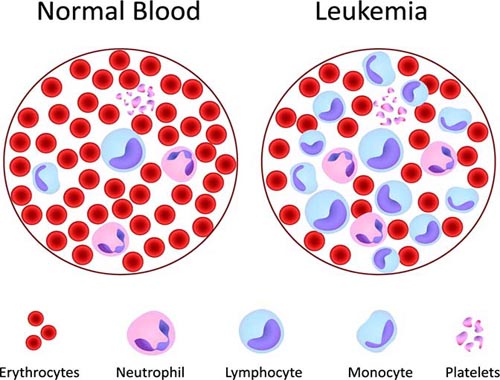Leukemia
Leukemia is a bone marrow disorder that arises when one abnormal white blood cell begins to continuously replicate itself. These cells do not function normally, they do not fight infection as they should, and they do not die at the same rate as other WBCs. As they accumulate, they inhibit the production of the other normal blood cells in the marrow, leading to anemia, bleeding, and recurrent infections. Over time, the leukemic cells spread through the bone marrow and bloodstream, where they continue to divide, sometimes forming tumors and damaging organs such as the kidney and liver. Since the spleen is responsible for filtering the blood and destroying old cells, it may become enlarged and swollen with the abnormal cells, as can the liver and lymph nodes. If the cells reach the central nervous system and build up in the cerebrospinal fluid that supports the brain and spinal column, they can cause headaches and seizures. Acute leukemia is often diagnosed because the affected person feels ill. The person may have symptoms related to not having enough normal blood cells, such as: Weakness, shortness of breath and anemia due to a lack of red blood cells; Bleeding and bruising due to a lack of platelets; Fever and infections due to a lack of normal infection-fighting WBCs; Those with acute leukemia may also have signs and symptoms related to accumulations of immature white blood cells, such as: bone and joint pain; enlarged lymph nodes, spleen, liver, kidneys, and testicles; and headaches, vomiting, confusion, and seizures (when excess cells collect in the brain or central nervous system). They may also experience weight loss and night sweats. Chronic leukemias often progress slowly and may be found by the doctor during a routine check-up before any symptoms are noticed, or they may cause milder forms of the same symptoms noticed with acute leukemia. Some cases may be monitored for years before they require treatment, while others may be more aggressive. The abnormal cell that is producing the chronic leukemia may also become unstable. Further changes in the cell may cause a blast crisis, leading to the production of only immature cells and a rapidly worsening condition.
